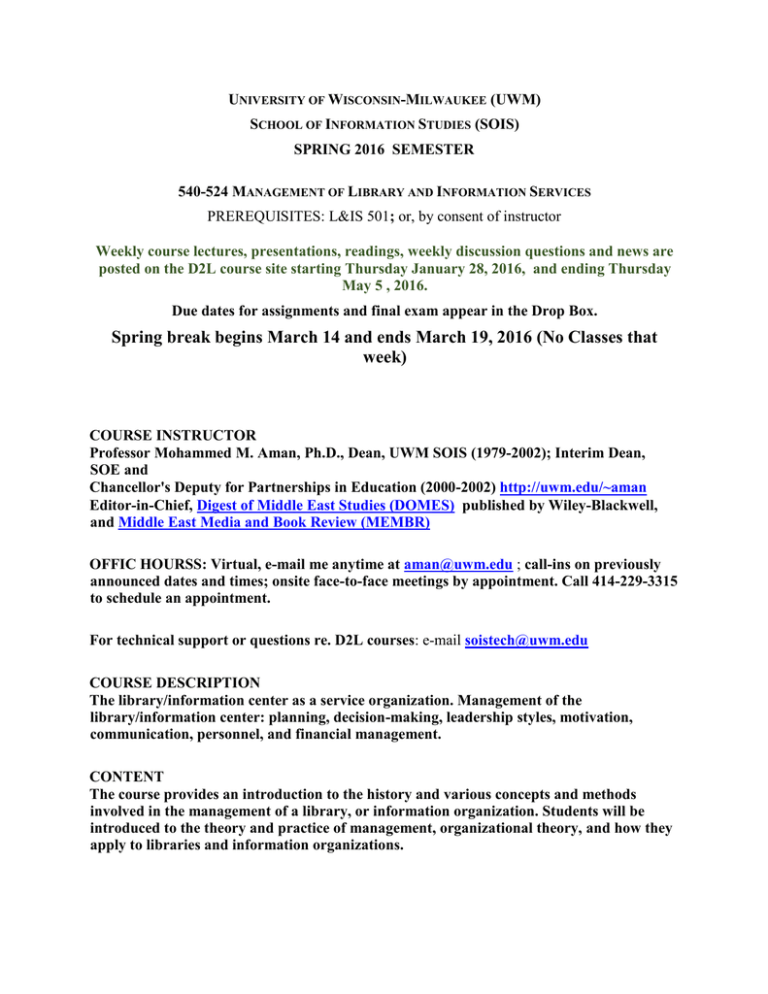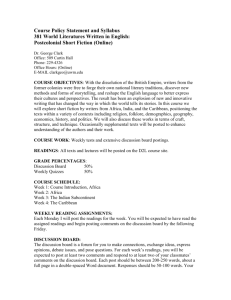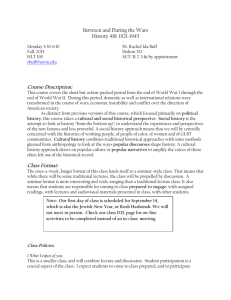
UNIVERSITY OF WISCONSIN-MILWAUKEE (UWM)
SCHOOL OF INFORMATION STUDIES (SOIS)
SPRING 2016 SEMESTER
540-524 MANAGEMENT OF LIBRARY AND INFORMATION SERVICES
PREREQUISITES: L&IS 501; or, by consent of instructor
Weekly course lectures, presentations, readings, weekly discussion questions and news are
posted on the D2L course site starting Thursday January 28, 2016, and ending Thursday
May 5 , 2016.
Due dates for assignments and final exam appear in the Drop Box.
Spring break begins March 14 and ends March 19, 2016 (No Classes that
week)
COURSE INSTRUCTOR
Professor Mohammed M. Aman, Ph.D., Dean, UWM SOIS (1979-2002); Interim Dean,
SOE and
Chancellor's Deputy for Partnerships in Education (2000-2002) http://uwm.edu/~aman
Editor-in-Chief, Digest of Middle East Studies (DOMES) published by Wiley-Blackwell,
and Middle East Media and Book Review (MEMBR)
OFFIC HOURSS: Virtual, e-mail me anytime at aman@uwm.edu ; call-ins on previously
announced dates and times; onsite face-to-face meetings by appointment. Call 414-229-3315
to schedule an appointment.
For technical support or questions re. D2L courses: e-mail soistech@uwm.edu
COURSE DESCRIPTION
The library/information center as a service organization. Management of the
library/information center: planning, decision-making, leadership styles, motivation,
communication, personnel, and financial management.
CONTENT
The course provides an introduction to the history and various concepts and methods
involved in the management of a library, or information organization. Students will be
introduced to the theory and practice of management, organizational theory, and how they
apply to libraries and information organizations.
COMPETENCIES TO BE GAINED FROM THE 524 COURSE
• Knowledge of historical issues and theories of management
• Understanding current organizational theories management practices
• Understanding human resource management issues
• Appreciation of diversity in the workforce and rules and regulations governing
selection, recruitment, and evaluation of personnel
• Familiarity with financial planning and budget control
• Appreciation of the roles and functions of leadership
• Gain familiarity with the literature on management and how they relate to the daily
operations of the library
• Understanding of the value of communication in managing an organization
• Learn about issues of ethics, crisis control and other matters as they pertain to
libraries and their management
REQUIRED TEXTBOOKS:
ONE IS REQUIRED, BUT IF YOU WISH AND CAN AFFORD TO
BUY TWO THIS WILL BE EVEN BETTER FOR YOUR EDUCATION AND
PROFESSIONAL DEVELOPMENT
STUEART, R. Title: LIBRARY & INFORMATION CENTER MANAGEMENT
Edition: 8TH Ed.
Cover: PB Pub.: ABC CLIO Sub Pub: LIBS UNL ISBN: 978-159884-989-9
OR
EVANS, E. Title: MANAGEMENT BASICS F/INFO.PROFESSIONALS
Edition: 3RD Ed.
Cover: PB Pub.: ALA Sub Pub: N SCHUMAN
1-55570-9099
ISBN: 978-
You may purchase one or both online from amazon.com
Take advantage of the UWM Library resources and services available to you. Visit the
Library home page at http://uwm.edu/libraries
Students with Disabilities
If you are a student with physical disability, please inform Prof. Aman on or before the first day of
the class. Make sure that you have completed the VISA application and consulted with the UWM
Office of Students with Disabilities.
Prior to the first lecture, please acquaint yourself with the various sections of the course on D2L,
read the posted syllabus more carefully, mark the due dates for assignments, postings, etc. on your
personal calendar and reminders, acquire the textbook(s), post your brief intro in the Coffee Shop
to help the virtual get-acquainted with your fellow classmates.
For technical support or questions: e-mail soistech@uwm.edu ; also the Learning
Technology Center (LTC) is here to support you, and there are plenty of resources to help
you learn how to use D2L.
You can sign up online for face-to-face workshops:
LTCworkshops.uwm.edu
Links to tutorials and quick answers can be found on the D2L MyHome
page under the heading "Need help using D2L?" You'll find:
Very basic D2L tutorials:
https://www4.uwm.edu/ltc/d2l/d2l_fast_help.cfm
Quick answers to common questions (search or click links to
find answers): http://d2ltipsandtricks.blogspot.com/
In-depth documentation provided by the vendor:
http://d2ltipsandtricks.blogspot.com/2011/05/desire2learnvendordocumentation.html
A useful updated First Day Handout for Students can be found online at:
http://d2ltipsandtricks.blogspot.com/2011/08/for-students-d2l-accessand-help.html.
Discussions
Regular postings to the Discussion Board are required and should be meaningful, add value, reflect readings and
comprehension of topics presented in class. Number of postings per lecture ONE. Number of meaningful responses
per lecture ONE. This is not to discourage more students interactions and dialogues as these can be done in the Coffee
Shop part of the course on D2L. Late postings are subject to reduced points.
Assignments
Due dates for submitting assignments are posted on the Course Drop Box link.
Late assignments are not accepted, or accepted with penalty if earlier valid excuse was approved by the instructor and
only one such is granted during the course. Special considerations are prescribed in UWM’s policy on “special
considerations” http://www.uwm.edu/Dept/SecU/acad%2Badmin_policies/S29.htm
Assignment 1
Select and compare one strategic plan (SP) from one type of library and compare it to one strategic plan of another
type of library (academic, public, school, special/corporate, law, medial, etc.). Your comparison should discuss and
compare the differences in missions, goals, objectives, planning, etc.). Give background information about each,
compare how different or similar the two are in light of your readings and the lectures, and comment on their strengths
and weaknesses as good, average or poor plans. SPs can be found on libraries’ web sites. Unfortunately not all libraries
are have them, so start and search early to find the right ones.
Assignment 2
You received a complaint (Choose ONLY ONE CASE) from:
1. One of your subordinates who is a lesbian claiming that she has been harassed repeatedly by the staff in the
department that you supervise.
2. A Latino employee was called derogatory names by one of the staff members and is threatening to file a
complaint with the EEOC.
3. A Muslim employee was denied permission by his supervisor to take time to pray during working hours.
What exactly are the requirements for his religion and could s/h be accommodated reasonably). You can
substitute the Muslim with any other religion practiced by the hypothetical employee and discuss what
implications that could present for similar religious practices.
As the supervisor of these individuals, describe the process you will follow and the actions that you will take to act on
one of the complaints and how to solve this problem of sexual, religious or ethnic harassment in your library. What
federal and state laws you believe are being violated; what actions and procedures must be followed, what remedies
do you recommend, etc.? Cite the laws and regulations, what actions should be taken, how to avoid future
situations/complaints, etc.
Assignment 3 FINAL EXAM
Final exam (is a take home exam) will be posted the last week of the course. Answers are due on the date shown in
the Drop Box link. It is expected that you go beyond the lectures and textbook to provide your answers to show wellroundedness and depth in your answers. Length: no more than one single page for each answer, single space for each
question in addition to a separate list for notes and cited references actually consulted and read by you in preparing
your answers to the questions. Refrain from extensive quoting and no cut and paste and try to express yourself in your
own words.
Expectations and Requirements for Formatting All Your Papers:
1. For all assignments it is expected that that you integrate outside reference/readings you actually used into
your presentation to support your arguments, express yourself and not just quoting others; try to use
subheadings, and conclude your papers with a conclusion and a list of outside sources you actually read and
consulted.
2. All submitted papers should be in MS Word. Use the APA (American Psychological Association) style or
the Chicago Style Manual for formatting your paper, citations, and references. At the top of our paper list
your name, course number and semester, your e-mail address. This is followed by the title of your paper.
Give your paper an introduction or abstract and conclude it with a meaningful short conclusion. Insert page
numbers and use subheadings and notes.
3. Use MS Word; single space, font size 10; font type: Times New Roman. Length of paper for each assignment
is about 2,500 words, not to exceed 3,000 words. Your cited references and footnotes “endnotes” should be
listed at the end of your paper with full bibliographic information preferably with a mix of print and URLs.
List only sources that you cited and used as sources for your writing.
Course calendar and corresponding readings from the required textbook(s)
Weekly discussion questions and additional readings are posted with each lecture. Lecture titles and textbook
readings are posted below. Your response to the discussion question(s) should be posted shortly after each
lecture but within the week of the lecture and before the next lecture begins.
WEEKLY LECTURES
READINGS FROM THE TEXTBOOKS ARE SUPPLEMENTED BY READINGS
ON STARTING
THURSDAY, JANUARY
28 AND ENDING ON
THURSDAY, MAY 5,
LISTED WITH EACH LECTURE ON THE COURSE D2L SITE
2016
Lecture 01:
Thursday Jan. 28
Introductions, The
Meaning & History of
Management
Lecture 02 Theories
& Theorists of
Management
Readings: Evans, Ch. 1; Stueart Ch.1
Lecture 03:
Mission, Goals &
Objectives
Readings: Evans, Ch. 4; Stueart Ch. 4
Lecture 04 Planning;
Strategic Planning
Readings: Evans, Ch. 5, 6, 7 Stueart Ch. 4,5
Lecture 05: Human
Resources (HR) I
Readings: Evans, Ch. 14; Stueart Ch. 10
Lecture 06: HR II:
Diversifying the work
force; staff
performance &
evaluation
Readings: Evans Ch. 9-10; Stueart Ch. 11-12
Lecture 07: Staff
Motivation
Readings: Evans, Ch. 12; Stueart Ch. 13
Lecture 08:
Communication in
the workplace
Readings: Evans, Ch. 8,9,11 Stueart Ch. 16
Lecture 9
Leadership
Readings: Evans, Ch. 13; Stueart Ch. 14 & 20
Lecture 10
Marketing
Readings: Evans, Ch. 4; Stueart, ch. 6
Lecture 11
Budgeting and
Fiscal Planning
Readings: Evans, Ch. 15; Stueart Ch. 19
Readings: Evans, Ch. 2, 3; Stueart , Ch. 2-3
Lecture 12
Facilities & Physical
Planning
Readings: Evans, Ch. 17
Lecture 13 Ethics
and
Crisis Management
Readings: Stueart, Ch. 15
Lecture 14
Course wrap up and
study period
Review and study week. Final Take Home Exam Posted on the
Course Site as the last entry in the Course Contents page
Final Exam posted
Sunday May 1st,
answers due in the
Drop Box by
Thursday May 5.
Upload your answers to the final exam to the Drop Box no later than 11:30PM
Thursday May 5th , 2016.
FINAL GRADES ARE POSTED ON ON PAWS ON SATURDAY
MAY 12, 2016.
Grade Distribution
Discussions
First assignment
Second assignment
Final term paper
——-
40%
10%
20%
30%
Total 100%
Grading Rubric and Criteria for Postings and Assignments
A= Excellent. Work demonstrates impressive understanding of readings, discussions, themes and ideas. Written work is
fluid, clear, analytical, well organized and grammatically polished. Reasoning and logic are well grounded, and the
information is precise and documented. High quality work which cites outside materials, draws connections between topics
from multiple sources and generally impressive.
B= Good. Demonstrates clear understanding of the topic. Work demonstrates a thorough and solid understanding of
readings, discussions, themes, and ideas. Written work is clear and competent, but is somewhat general, somewhat vague,
and lacking precision. While analytical, the writing represents more prescription and analysis.
C= Fair. Shows limited understanding and/or limited amount of effort. Work demonstrates a somewhat fragmented
understanding of readings, discussions, themes and ideas; shows acquaintance with readings and ideas, but not intellectual
engagement. Written work is choppy, and writing is difficult to follow. Ideas are imprecise, fractured, and unclear.
Submission has little logical development, and reveals little effort to apply to the assignment.
D= Unsatisfactory. Work demonstrates little or no understanding with the readings, discussions, themes and ideas. Written
work lacks clarity and shows poor understanding of the subject and less than limited effort.
F= Fail. Fails to meet the minimum requirements or respond to instructor’s communications and warnings. Work does not
demonstrate understanding of topics, ideas and readings. F grade is also given when work is not submitted and/or
plagiarized.
Exemplary
Grading Criteria
Variations of
A grade
Satisfactory
Variations of
B grade
Unsatisfactory
Variations of
C grade
Questions were answered correctly and fully
Answers demonstrate knowledge of the subject and
readings
Content of the paper is consistent with research, theory,
practice, and good writing
Response(s) to the question(s) are systematic, wellorganized and articulated clearly in student’s own words
The paper meets the minimum length requirement,
including accurate and sufficient citations, format and
conforms to quality academic graduate level writing.
Grade Scale According to the UWM Graduate Bulletin
96-100
91-95.99
87-90.99
84-86.99
80-83.99
77-79.99
A
AB+
B
BC+
74-76.99 C
70-73.99 C67-69.99 D+
64-66.99 D
60-63.99 DBelow 60 F
========================================================
© 2016 by Prof. Mohammed M. Aman. All rights reserved. No part of this material may be reproduced, stored in a retrieval system, or
transcribed, in any form or by any means, without prior written permission of author Dr. Mohammed M. Aman, School of Information
Studies, University of Wisconsin – Milwaukee, Milwaukee, WI 53211
ENJOY THE COURSE








